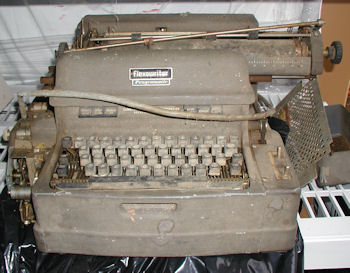Negibus or Posibus?
SHARE |
|
 
|
by Bill Degnan - 01/17/2023 15:29 |
|
I am working to understand this TU56 as it came from an unknown environment. The apparent peripheral connecting cable (a W850 C (~1966)) that came with the TU56 reads "PDP9" on one end and "TC02 E&F" on the other. I wondered if this cable is actually associated with the TU56 or just sitting in the same box before the TU56 came to me.
https://www.vintagecomputer.net/digital/TU56/TU56_PDP9-connector.png https://www.vintagecomputer.net/digital/TU56/TU56_backplane-cards.png Research/sources: https://gunkies.org/wiki/TU56_DECtape_Transport On this page, one can see photos of the backplane. Note how a TU56 could have had a M531 or a G742 installed to serve as a bus converter. THe M531 is for buses with negative logic controllers and the G742 is for when one has a positive logic controller. Jumping a few steps ahead in thought, if the TU56 was attached to a PDP-9, would you expect the TU56 to have a G742 or M531? This would help prove whether the TU56 was indeed used with a PDP-9. Note that newer PDP8 and PDP11's were positive bus. I found a good general description of how the negative / positive relates to the PDP-8 and how peripherals fit into the picture. https://homepage.cs.uiowa.edu/~dwjones/pdp8/models/ "The "negibus" or negative logic I/O bus used -3 and 0 volt logic levels in 92 ohm coaxial cable" - a M531 would be used if attaching to a computer with a negative bus. A G742 indicates the computer using the TU56 had some form of positive logic bus. The positive I/O bus, or posibus, was a 100 ohm bus clamped between 0 and 3 volts with TTL drivers and receivers. Does this mean, no this TU56 would not be compatible with a PDP9? Not so fast! - The W850 C (~1966) cable that connects the TU56 to the external peripheral possibly appears to convert the posibus to a negibus as described in the above uiowa.edu link. So, I am thinking the presence of a G742 does not alone indicate the computer using the TU56 must have a positive logic bus. It might simply be that someone tried to attach a "new at the time" TU56 to an "old at the time" PDP-9, around 1976 and they needed to make due with whatever cables were available. It would have been easier to use a straight-through cable with a M531, but these were not available? Just a guess. Note the 18 connectors are present: https://www.vintagecomputer.net/digital/TU56/TU56_PDP9-connector.png PDP-9 and earlier PDP8's were negative logic computers. Thus a TU56 with a G742 would have needed the W850 C to make it compatible with a negative logic computer, the PDP-9 to operate correctly. I think. Considering 1) We have a 18-wired jumper bus adapter (W850 C) on the other end of the TU56 positive bus that I believe would convert the signal to negative 2) THe "PDP9" printed on the adapter. 3) The other side of the cable reads "TC02 E&F" (I believe). I know PDP-9's attached to TU55's, but when PDP-9's manuals were printed the TU56 was not yet invented. I did find that TU56's could be used with TC02 peripheral backplanes (such as an expansion box). TU56 and TC02: http://www.bitsavers.org...aintenance%20Manual.pdf See page 22 (1) For a TU56M or TU56MH Transport: controller-to-transport information cable = 70-06412, transport-totransport (other TU56 or TU56H in system) information cable = 74-5152. See Note 2 for TU56M or TU56MH connected to a TD8/e Controller. (2) When a TU56M or TU56MH is connected to a TDa TD8/e Controller, only one 70-08447 cable is used for both commands and information. This cable has both a single-height and a double-height connector module on the termination end. Insert the single-height connector into slots A061 A07 and the double-height connector into slots AB 1 01 AB I I. Reply |
|
Resources:

Popular Topics and FAQs
Past Issues:
Before we switched over to a blog format, past page archives here:
Vintage Computer Festival East 3.0 June 2006
Commodore B Series Prototypes July 2006
VOLSCAN - The first desktop computer with a GUI? Oct 2006
ROBOTS! - Will Robots Take Over? Nov 2006
Magnavox Mystery - a Computer, or? Jan 2007
The 1973 Williams Paddle Ball Arcade Computer Game Feb 2007
The Sperry UNIVAC 1219 Military Computer May 2007
VCF East 2007 - PET 30th Anniversary June/July 2007
The Electronic Brain August 2007
Community Memory and The People's Computer Company October 2007
Charles Babbage's Calculating Machine December 2007
Vintage Computing - A 1983 Perspective February 2008
Laptops and Portables May 2008
From Giant Brains to Hobby Computers - 1957 to 1977 August 2008
Historic Computer Magazines November 2008
World's Smallest Electronic Brain - Simon (1950) December 2008 - Feb 2009
Free Program Listings Spring 2009
Computer Music Summer 2009
Popular Electronics Jan/Feb 1975 - Altair 8800 Fall 2009
Early Microcomputer Mass Storage Summer 2010
Flexowriter

This image was selected at random from the archive. Click image for more photos and files from this set.